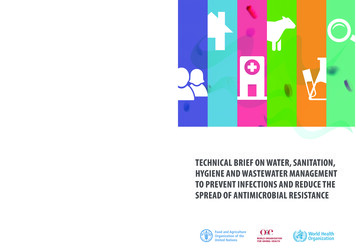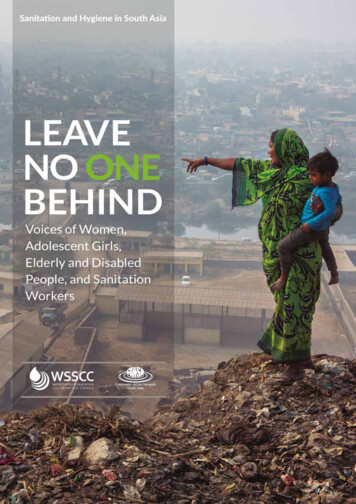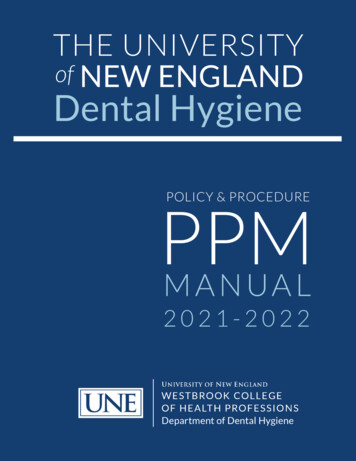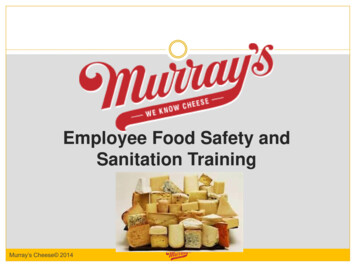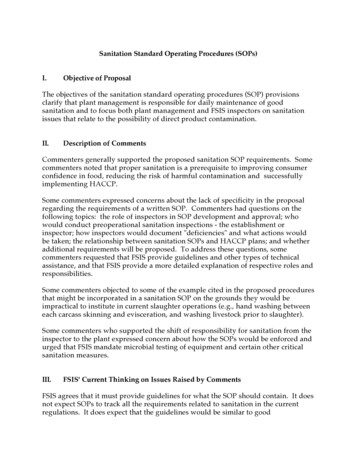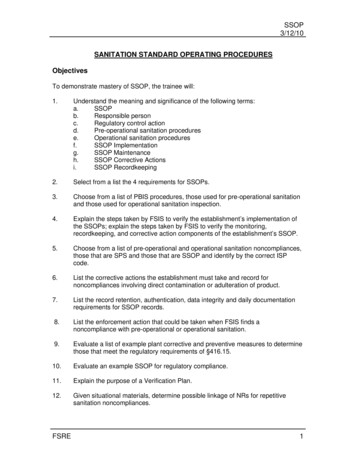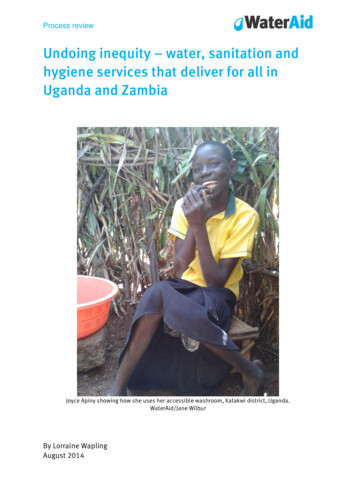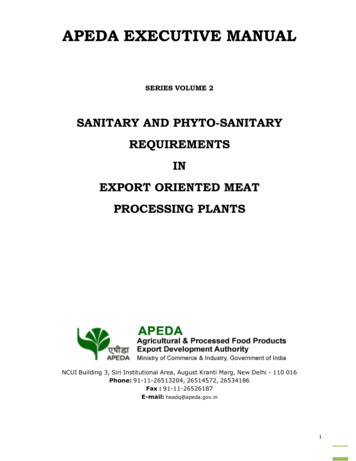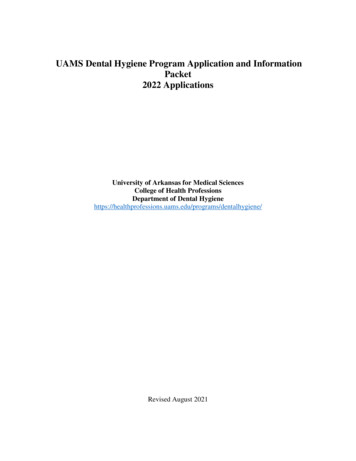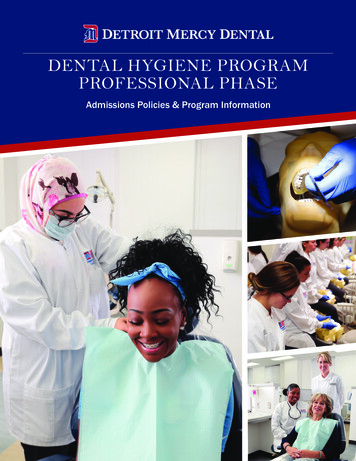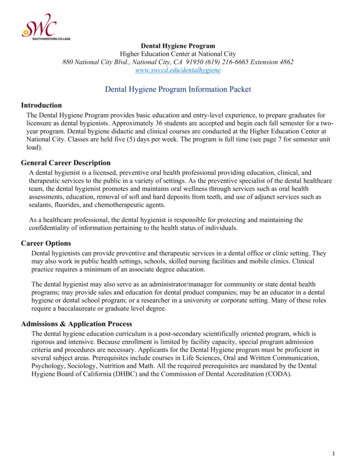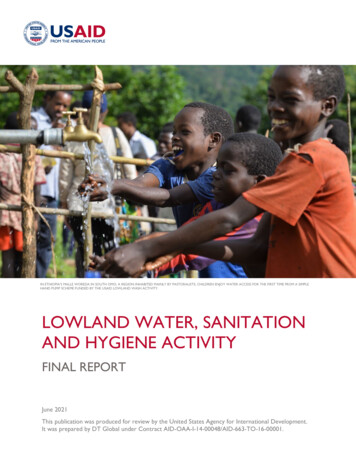
Transcription
IN ETHIOPIA’S MALLE WOREDA IN SOUTH OMO, A REGION INHABITED MAINLY BY PASTORALISTS, CHILDREN ENJOY WATER ACCESS FOR THE FIRST TIME FROM A SIMPLEHAND PUMP SCHEME FUNDED BY THE USAID LOWLAND WASH ACTIVITY.LOWLAND WATER, SANITATIONAND HYGIENE ACTIVITYFINAL REPORTJune 2021This publication was produced for review by the United States Agency for International Development.It was prepared by DT Global under Contract AID-OAA-I-14-00048/AID-663-TO-16-00001.
USAID LOWLAND WATER,SANITATION AND HYGIENEACTIVITYFINAL REPORTContract No:AID-OAA-I-14-00048 AID-663-TO-16-00001Submitted to:USAID EthiopiaPrepared by:DT GlobalDisclaimer:The authors’ views expressed in this document do not necessarily reflect the views of the United StatesAgency for International Development or the United States Government.Final Report USAID Lowland Water, Sanitation and Hygiene Activityi
CONTENTSAcronyms . vExecutive summary. 1Background and Context . 1Activity Results . 1Lessons Learned. 3lessons learned & The Way Forward . 5Performance Indicator Results Table . 7Background and Context. 8Activity Authorization . 8Geographic Scope . 9Project Approach. 10Resilience and sustainability . 10Collaborating, learning, and Adapting. 11Organizational Structure . 12Expanded review of Activity . 13Component 1: Increased Access to Improved Drinking Water Supply Sources on a SustainableBasis . 13Improved Water Supply Infrastructure. 14Strengthened Water Supply Services . 21Functionality Monitoring Sensors . 24Lessons Learned . 25Component 2: Increased Adoption Of Key Hygiene Behaviors And Increased Access ToImproved Sustainable Sanitation. 29Sustained Adoption of Key Hygiene and Sanitation Practices . 29Improved Supply Of Hygiene And Sanitation Products And Services . 32Learning events and Assessments . 36Lessons Learned . 41Component 3: Improved Efficiency And Sustainability Of Food Production From Irrigated AndRain-Fed Agricultural System . 44Improved Natural Resource Management . 45Improved and Sustainable Small-Scale Irrigation . 47Lessons Learned . 48Component 4: Improved Water Resource Governance And Data Management . 50Improved Wash Planning And Data Management Capacity. 50Improved WASH Data Management . 52National and Regional Level Guidelines And Policies. 57Final Report USAID Lowland Water, Sanitation and Hygiene Activityii
Lessons learned . 62Cross Cutting . 63Monitoring And Evaluation . 63Gender And Social Inclusion . 64Environmental Compliance . 66Collaboration . 67External Communications . 69Lessons Learned & The Way Forward . 71Sanitation and Hygiene interventions require water . 71Construction quality in resource poor environments . 71Private Sector engagement . 72activity implementation THROUGH a Learning lens . 73the importance of Systems Strenthening . 73Final Report USAID Lowland Water, Sanitation and Hygiene Activityiii
TABLE OF TABLESTable 1. Performance Indicator Results Table . 7Table 2. Organizational Structure. 12Table 3. Key Indicators: Improved Water Supply. 14Table 4. Types of Water Schemes by Technology . 15Table 5. Number of Institutions that Gained Access to Basic Drinking Water Services . 15Table 6. Water Schemes Constructed and Rehabilitated by the USAID Lowland WASH Activitywith UNICEF Collaboration. 21Table 7. Key Indicators: Strengthened Water Supply Services . 21Table 8 Example of Tariffs for Activity Water Schemes . 24Table 9. Key Indicators: Improving Water Supply Data Management . 24Table 10. Sensor Type by Region . 25Table 11. Key Indicators: Sustained Adoption of Key Hygiene and Sanitation Practices . 29Table 12. ODF Achievement by Region. 31Table 13. Key Indicators: Improved Supply of Hygiene and Sanitation Products and Services . 32Table 14. Key Indicators: Improved Natural Resource Management. . 45Table 15. Key Indicators: Improved and Sustainable Irrigation . 47Table 16. Small Scale Irrigation Schemes . 47Table 17: Number of Individuals Supported by Short Term Agriculture Sector Productivity orFood Security Training. 48Table 18. Key Indicator . 50Table 19: Number of Government Staff Trained on Asset Inventory and Asset ManagementSystem. 51Table 20. Key Indicator . 52Table 21. Key Indicator . 57Table 22. Results of Core Outcome Indicators at the Baseline and Endline . 63Table 23. USAID Lowland WASH External Communications . 69Table 24. Summary Details of Water System Constructions and Rehabilitations through ActivityPeriod of Performance . Error! Bookmark not defined.Table 25. Summary Details and Status of 126 ODF Verified Kebeles . Error! Bookmark not defined.Table 26. Summary Details and Status of 42 ODF Verified Villages . Error! Bookmark not defined.Final Report USAID Lowland Water, Sanitation and Hygiene Activityiv
ACRONYMSAWDAcute Watery DiarrheaCDCSCountry Development and Cooperation StrategyCARECooperative for Assistance and Relief Everywhere (Lowland WASH subcontractor)CLACollaboration, Learning and AdaptingCOPChief of PartyCLTSHCVDACWACommunity-Led Total Sanitation and HygieneCommon Vision for Development Association (local NGO)Consolidated WASH AccountDCOPDeputy Chief of PartyENGINEEmpowering the New Generation to Improve Nutrition and EconomicOpportunities (USAID-funded activity)EWTIEthiopian Water Technical InstituteEHAETBEnvironmental Health AgentsEthiopian BIRRFeMSEDAFederal Micro and Small Enterprises Development AgencyGoEGovernment of EthiopiaIBEXIntegrated Budget and Expenditure systemFGDHEWICTIDIQIECIRCFocus Group DiscussionsHealth Extension Worker (Keeble-level GOE staff under Ministry of Health)Information and Communications TechnologyIndefinite Delivery Indefinite Quantity (contracting mechanism for USAID)Information, Education and CommunicationInternational Rescue Committee (Lowland WASH subcontractor)IRC-WASHInternational Water and Sanitation CentreM&EMonitoring & EvaluationMISManagement Information SystemLowland WASH USAID Lowland Water, Sanitation and Hygiene ActivityMHMMoWIENRMMenstrual Hygiene ManagementMinistry of Water, Irrigation and ElectricityNatural Resource ManagementFinal Report USAID Lowland Water, Sanitation and Hygiene Activityv
NRMCNatural Resource Management CommitteeODFOpen Defecation FreeOWDAOgaden Welfare and Development AssociationPOTENTIALPromoting Opportunities through Training, Education, Transition Investment andLivelihoods (USAID-funded activity)NWI2O&MOWNPNational WASH Inventory 2Operations and MaintenanceOne Water, Sanitation and Hygiene National ProgramPRIMEPastoralist Areas Resilience Improvement and Market Expansion (USAID-fundedactivity)ROReverse OsmosisRESTRWBSNNPRSTTASYGEToTTVETRelief Society of Tigray (local NGO)Regional Water BureauSouthern Nations, Nationalities and Peoples’ RegionShort Term Technical AssignmentSave Your Generation Ethiopia (NGO)Training of TrainersTechnical and Vocational Education and TrainingUSAIDUnited States Agency for International DevelopmentWASHWater, Sanitation and HygieneWADIWASHCOWaTERWWOZWOWater and Development IDIQ mechanismWater, Sanitation, and Hygiene Committee (at community level), previously calledWMC (Water Management Committee)Water, sanitation and hygiene Transformation for Enhanced Resilience (USAIDfunded activity)Woreda Water OfficeZonal Water OfficeFinal Report USAID Lowland Water, Sanitation and Hygiene Activityvi
EXECUTIVE SUMMARYBACKGROUND AND CONTEXTThe purpose of the USAID Lowland WASH Activity is to accelerate the expansion of improved,sustainable drinking water supply and sanitation access and to catalyze enhanced hygiene behaviors,while also expanding sustainable water use for agriculture in the Somali, Afar and Southern Nations,Nationalities and Peoples (SNNP) regions of Ethiopia with populations vulnerable to drought and climatechange. The Activity is aligned with USAID’s Water and Development Strategy (2013-18) andUSAID/Ethiopia’s Country Development and Cooperation Strategy (CDCS) Development ObjectiveOne, “increased economic growth with resilience in rural Ethiopia,” and Feed the Future’s goals of“reducing hunger and malnutrition in Ethiopia,” and “increasing the resilience of vulnerable communitiesand households.”The USAID Lowland WASH Activity is a critical piece of the U.S. Government’s contribution to theGoE’s One WASH National Program (OWNP)—a government-driven, sector-wide approach tocomprehensively address the WASH needs of rural, urban, and pastoralist communities, schools, andhealth posts in an integrated manner across sector ministries and institutions.The Activity has the following four objectives:1. Increased access to improved drinking water supply sources on a sustainable basis;2. Increased adoption of key hygiene behaviors and increased access to improved sustainablesanitation;3. Improved efficiency and sustainability of food production for irrigated and rain-fed agriculturalsystems; and4. Improved water resource governance and data managementActivities were conducted across a total of 35 target Woredas. This includes a total of nine woredas inAfar, three in SNNP, and 23 in Somali.ACTIVITY RESULTSProvided more than 260,000 people,including 107,364 women, withimproved drinking water services.Throughout the course of theActivity, 131 water schemes wereconstructed, including 35 newconstruction projects and 96rehabilitations. Twelve of these waterschemes were solar powered, improvingwater scheme sustainability and climateresilience. In addition, the Activitycollaborated with governmental and privateFinal Report USAID Lowland Water, Sanitation and Hygiene ActivityKIDS FETCHING WATER AT MALE WEREDA ALEZE KEBELE.PHOTO CREDIT: USAID LOWLAND WASH ACTIVITY.1
sector partners to leverage 1.7 million in support. This included the construction of a reverse osmosiswater scheme in Serdo and having handpumps installed in the drought-prone Somali region. The Activitywas also able to connect 41 institutions, schools, and healthcare facilities to new or rehabilitated waterschemes.Around 95% of water schemes now have a tariff in place to cover recurrent O&M costs,managed through community-based WASHCO organizations. The Activity revitalized orestablished 131 WASHCOs and trained 944 individuals, including 400 women. Professionalizationtrainings focused on community-based management, financial management, tariff setting, and basic O&M.Engaged approximately 160 local, zone, and Woreda government staff in visits, capacitybuilding trainings, and on-the-job trainings. Trainings primarily focused on building capacity inrural water scheme maintenance, for both photo-voltaic pumping (PVWP) systems and electormechanical equipment. Both theoretical and practical trainings were offered, with participants travelingto practice together in real time.Installed 270 remote monitoring sensors on motorized boreholes in Afar and Somali totrack water system functionality. Trained government partners in sensor installation, maintenance,and data collection.Facilitated the certification and verification of 126 open-defecation free (ODF) kebeles andsaw a 19.5% increase from the baseline in proper handwashing practices. Utilizing the GoENational Strategy, the Activity implemented Community Led Total Sanitation and Hygiene (CLTSH) toincrease adoption of improved sanitation and hygiene practices. As a result, over 277,000 people gainedaccess to basic sanitation, resulting in an observed 2.7% reduction in childhood diarrhea.Engaged 20,147 people in natural resource management awareness raising activities,establishing, and training 136 Natural Resource Management Committees. As a complementto WASH activities and in support of a Do-No-Harm approach, the Activity worked closely withworeda and kebele level government partners to enhance community skills, their knowledge of NRM, toencourage experimentation with local and new NRM techniques, and to promote their activeparticipation in all NRM activities with major focus around critical water facility catchment areas.Designed an innovative cloud-based asset management system (AMS) that provides realtime water system data to allow for better decision-making in O&M. In close collaborationwith government partners, the activity piloted a digital AMS which includes detailed information such as:borehole and submersible pump information; pumping test results design calculations; equipmentspecifications; functionality information; GPS coordinates; information about the WASHCO; and dataabout the water distribution system. Within the tool, a customized ticket-based issue system wascreated to track and manage O&M requests at the Woreda level. The initial pilot was conducted in theAfar region and subsequently scaled up to Somali and SNNPR.Contributed to 20 policies and guidelines for the national level Government of Ethiopia.The USAID Lowland WASH Activity contributed to a total of 12 policies and four strategies, plus fourguidelines’ recommendations on WASH planning and management over the course of the Activity.These products were directly based on assessments or experiences of working with remote, pastoralistcommunities. The policies and guidelines contributed to include National Water Policy, Water QualityFinal Report USAID Lowland Water, Sanitation and Hygiene Activity2
Monitoring Policy, National ODF Campaign Framework, National Rural Water System Design Guidelineand Standard, National Standard on Solar Water Pumping, and the creation of a national level platformthrough which stakeholders can share learnings and advocacy tools and identify and pilot promisingmanagement models and resources to ultimately improve the management of rural water services.LESSONS LEARNEDConstruction Quality: Activityconstruction sites are remote andoften lack information essential fordesign and construction. In addition,supply chains are weak for materialsand there a lack of skilled contractorsand labor. Finally, there were weakcommunications from variousstakeholders. Despite these challenges,the Activity staff worked closelypartners and quality assurancecontractors, as well as the USAIDEngineer, in order to close over 1,100construction quality issues flagged,totaling 98% of all issues over the 5year Activity.COMMUNITY DISCUSSING WITH GUSTS AND FETCHING WATER AT ALUMA WATERPOINT IN MALE WEREDA ALEZE KEBELE.PHOTO CREDIT: USAID LOWLAND WASH ACTIVITY.Post Construction Sustainability: Ensuring that all new or rehabilitated water schemes are properlymaintained and continue providing clean water to communities is a key challenge of WASH activities inEthiopia. Due to a lack of private sector support for rural water supply, this responsibility lies withgovernment partners, who severely lack both capacity and personnel. The Activity focused on buildingcapacity within government partners to conduct O&M, and to professionalize WASHCOs, therebyestablishing a foundation for privatized service delivery.Risk with drilling: Drilling of boreholes in lowland areas is often difficult, time consuming, and costlydue to uncertainties with water quality and/or water availability. To mitigate this risk, the Activitycollaborated with three regional government partners to use boreholes which had previously beendrilled and found productive by regional governments, allowing for stronger ownership over the waterschemes by the local government.Sensor sustainability: Ethiopia faces recurrent, and at times long, internet and GSM signal outages.There was one instance where the outage was significant and resulted in all GSM sensors failing formore than six months. In order to combat this challenge, the Activity worked with SweetSense toenable the use of a lithium battery that would not require as frequent maintenance. The Activity alsoengaged with EthioTelecom to discuss noninterrupted sensor data flow during future potential internetshutdowns.CLTSH in pastoralist communities: The Activity was the pioneer implementor for large scaleCLTSH activities in the pastoralist regions of Ethiopia and faced difficulties in implementing handwashingFinal Report USAID Lowland Water, Sanitation and Hygiene Activity3
behavior changes and achieving ODF certification at the kebele level, as originally planned. Challengesincluded the nomadic pastoralist environment causing reluctance to invest in permanent latrine andhandwashing structures. Lack of resources also made it difficult to invest in improvements to latrines orto buy soap specifically for handwashing. In addition, there were institutional gaps limiting the ability oflocal government partners in sustaining momentum to ODF certification. Finally, logistics in traveling tothese remote communities made it incredibly difficult to administer post triggering and follow upactivities as necessary to achieve ODF and improvements to hygiene. Based on this experience, theActivity successfully advocated to change the Somali and Afar regional government definition for ODFfrom Kebele level to village level, given the wide geographic spread and nomadic nature of thesecommunities. In addition, the Activity also suggests redefining the hygiene indicator to allow soap to bekept elsewhere in the household, understanding constraints to keeping soap permanently at thehandwashing station.Sanitation marketing: The Activity observed that activities enabling artisans to build concrete slabswere not very successful. Based on informal assessments, concrete slabs are difficult to sustain as abusiness in part due to lack of demand. Further investigation/study is required to distinguish betweenproduct failure, business model failure, or market failure. A basic observation by the Activity indicatedthat demand for improved latrines among the targeted community was too low and the cost was toohigh for this model to prove successful.Resource and capacity of health extension workers: The Activity originally intended forgovernment partners such as HEWs and WHOs to conduct most of the follow up CTLSH activities.However, the capacity of the government partners was limited in both technical knowledge andoperational abilities. In response to this challenge, the Activity planned all CLTSH visits to thecommunity, provided per diems for government staff, and also technically supported the triggering tobuild further capacity of the regional governments to ensure sustainability long term.Natural resource management: While the creation of NRM plans was useful in emphasizing theenvironmental do-no-harm approach, several technical, economic, and cultural constraints impededsuccess. Most importantly, NRM is time consuming and sometime costly for rural pastoral communities.As such, the Activity linked NRMCs with local government partners in an attempt to provide additionalresources and capacity. However, in order for NRM to have a successful outcome in WASH projects, itmay require a larger budget and focus to make an impact.Small scale irrigation: The Activity faced construction challenges similar to those that the waterscheme construction projects experienced, including a lack of skilled labor and contractors; this wasespecially difficult considering SSIs are subject to competing priorities from various entities, includinglocal government and community members, which are often difficult to predict and accommodate. TheActivity captured lessons learned from each of these unforeseen challenges and incorporated relevantexperience into the Engineering Design Guidelines. This resource helped build the capacity ofconstruction of SSI schemes.Asset management system: The introduction of the cloud-based system and new technologies tolocal government partners was challenging; design and uptake of new technologies can be slow tomeasure and slow to show progress. The GoE did not have key data on rural water scheme assets,therefore a significant amount of time and resources went into on gathering data and integration. TheFinal Report USAID Lowland Water, Sanitation and Hygiene Activity4
Activity overcame some of these challenges by leveraging partnerships with IRC WASH, SweetSense,mWater, and others who all contributed to the cost and building of the AMS. In addition, the Activityalso hired locally based embeds to assist, encourage, and track usage of the AMS in hopes ofencouraging uptake.Policies and guidelines: The Activity was the primary advocate, both at the national and local level,for contextualized WASH policies suitable to lowland, pastoralist communities. While the national,subnational, and regional governments were very open to accepting recommendations, the challenge liesin operationalizing policies, guidelines, and strategies, particularly at the subnational level. Nevertheless,the Activity made 20 recommendations to national and regional guidelines and policies based onexperience working with lowlands communities.LESSONS LEARNED & THE WAY FORWARDThroughout implementation of activities, the USAID Lowland WASH Activity has celebrated itssuccesses while documenting and sharing its challenges and lessons learned. The most important lessonfrom the Activity’s work: Collaboration with regional governments, local partners, and communities isessential to best understand the contextual challenges and solutions required for the Ethiopian lowlands.Throughout this Activity, our staff worked in close partnership with our subcontractors (local andinternational), as well as with the GoE, local institutions, other donors, and other USAID projects.These collaborations included activity design in work-planning, implementation, monitoring, pause andreflect sessions, and learning events —all of which sought to achieve holistic success with long-termsustainable impacts.Sanitation and hygiene interventions require water: Through five years of implementing CLTSH,the Activity found that communities situated near a reliable clean water source were more likely toachieve success in ODF certification. Future CLTSH activities should focus on communities with existingwater service or an upcoming plan for new water services.Construction quality inresource poorenvironments: During theActivity, a variety ofconstruction challenges wereencountered, and the Activitydevoted extensive time torectifying construction qualityissues. While this process isnormal for infrastructureprojects with i
WMC (Water Management Committee) WaTER Water, sanitation and hygiene Transformation for Enhanced Resilience (USAID- . Installed 270 remote monitoring sensors on motorized boreholes in Afar and Somali to track water system functionality. . access to basic sanitation, resulting in an observed 2.7% reduction in childhood diarrhea.
